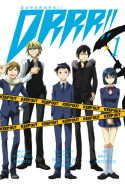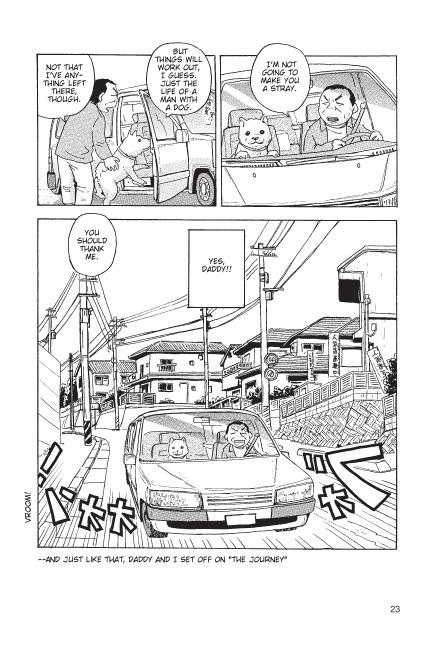Maria Kawai, heroine of A Devil and Her Love Song, is a cool customer. Not only is she beautiful, talented, and smart, she’s also tough — so tough, in fact, that she was expelled from a hoity-toity Catholic school for beating up a teacher. Her blunt demeanor further cements her bad-girl impression; within minutes of enrolling at a new high school, she antagonizes all the girls in her class with a few sharp observations about their behavior. Only two boys — Yusuke, a cheerful, popular student who avoids conflict at all costs, and Shin, a moody outsider — try defending Maria from her peers’ nasty comments and pranks.
So far, so good: Maria is spiky and complicated, a truth-teller who lacks the ability to censor herself, even though she’s aware of the potential consequences of speaking her mind. Throughout volume one, there are some wonderful comic moments as Maria struggles to put a “lovely spin” — Yusuke’s term — on her acid comments. Alas, Maria’s sideways head-tilt and doe-eyed gaze look more sinister than cute; not since Kazuo Umezu’s Scary Book has a manga-ka made a doll-like character look so thoroughly menacing, even when superimposed atop a backdrop of flowers and sparkles.
Having created such a vivid character, however, Miyoshi Tomori isn’t sure where to go with the story. In several scenes, Maria does things that contradict what we know about her: would someone as perceptive as Maria willingly attend a party hosted by the class mean girls, especially after they’d harassed her on a daily basis? And why would someone as outspoken as Maria refrain from pointing out her teacher’s judgmental behavior — especially when it’s plainly obvious to both the characters in the story and the reader? These kind of abrupt reversals might make sense if we knew more about Maria’s past, but at this stage in the story, they feel more like authorial floundering than a conscious revelation of character.
From time to time, however, Tomori convincingly hints at Maria’s softer side. Midway through volume one, for example, Maria makes tentative overtures towards Tomoya “Nippachi” Kohsaka, a fellow bullying victim. (“Nippachi” means “twenty-eight,” and is a mean-spirited reference to Tomoya’s poor academic performance.) That scene is both sad and real; anyone who’s ever seen two ostracized kids turn their classmates’ scorn on one another will immediately appreciate the dynamic between Maria and Nippachi. Maria’s exchanges with Shin, too, reveal a different side of her personality; though the pair frequently engage in the kind of rapid, antagonistic banter that’s de rigeur for romantic comedies, their quieter conversations suggest a grudging mutual respect.
Maria’s interactions with Nippachi and Shin fill me with hope that A Devil and Her Love Song will find its footing in later chapters. If Tomori can find a way to reveal Maria’s fundamental decency without compromising her heroine’s tart, outspoken personality, A Devil and Her Love Song will be a welcome addition to the Shojo Beat catalog, an all-too-rare example of a story in which the heroine isn’t the least bit concerned with being nice or popular. If Tomori can’t, Devil runs the risk of devolving into a YA Taming of the Shrew, with Shin (or, perhaps, Yosuke) playing Petruchio to Maria’s Katherina.
Review copy provided by VIZ Media, LLC. Volume one will be released February 7, 2011.
A DEVIL AND HER LOVE SONG, VOL. 1 • BY MIYOSHI TOMORI • VIZ MEDIA • 200 pp. • RATING: TEEN (13+)








 The goal is to make a stack of dice that’s worth as many points as possible without “busting”, which means getting a “0” score for that round. When creating your stack, each die added to the stack must be the same or higher value than the die below it. This is not a dexterity game, so if the stack falls over there is no penalty; simply rebuild it.
The goal is to make a stack of dice that’s worth as many points as possible without “busting”, which means getting a “0” score for that round. When creating your stack, each die added to the stack must be the same or higher value than the die below it. This is not a dexterity game, so if the stack falls over there is no penalty; simply rebuild it. Once per round, a player may take a “mulligan” to attempt to get better results. However, only two dice are rerolled and both of them must be able to be added to the stack.
Once per round, a player may take a “mulligan” to attempt to get better results. However, only two dice are rerolled and both of them must be able to be added to the stack.  Smirk & Dagger games are generally known for having a “take that” aspect to them. Sutakku didn’t originally have anything like this in the game, and apparently during pre-release plays the fans and reviewers were disappointed in this oversight. Personally, I don’t understand the mentality that a game company should be required to live up to some sort of reputation for a specific mechanic in all of their games, but regardless the call for player screwage was answered and some bonus cards were added to the game.
Smirk & Dagger games are generally known for having a “take that” aspect to them. Sutakku didn’t originally have anything like this in the game, and apparently during pre-release plays the fans and reviewers were disappointed in this oversight. Personally, I don’t understand the mentality that a game company should be required to live up to some sort of reputation for a specific mechanic in all of their games, but regardless the call for player screwage was answered and some bonus cards were added to the game.


 The deck consists of 50 cards in five colors (red, orange, blue, black and green). Each color consists of the following cards: 1,1,1,2,2,3,3,4,4,5. At the beginning of the game, the cards are shuffled together and a hand of either 4 (4 or 5 players) or 5 (2 or 3 players) is dealt to everyone. The cards are picked up by each player with the backs facing them so that they cannot see their own hands but may see everyone else’s. The game also includes colored tokens. 8 blue tokens are placed on the table in the box cover and three red tokens are placed next to the box cover on the table.
The deck consists of 50 cards in five colors (red, orange, blue, black and green). Each color consists of the following cards: 1,1,1,2,2,3,3,4,4,5. At the beginning of the game, the cards are shuffled together and a hand of either 4 (4 or 5 players) or 5 (2 or 3 players) is dealt to everyone. The cards are picked up by each player with the backs facing them so that they cannot see their own hands but may see everyone else’s. The game also includes colored tokens. 8 blue tokens are placed on the table in the box cover and three red tokens are placed next to the box cover on the table. When discarding a card, you will simply declare that you are discarding a card and then place that card in the discard area. This card is out of play permanently, but it will now be visible to everyone including yourself. You then draw a card from the deck so that you have the same number of cards that you started with. But more importantly, you may return one of the blue tokens to the box cover. This is how you “recycle” the blue tokens so that more clues can be given. Remember, you only start with 8 blue tokens and no one knows anything about his own hand!
When discarding a card, you will simply declare that you are discarding a card and then place that card in the discard area. This card is out of play permanently, but it will now be visible to everyone including yourself. You then draw a card from the deck so that you have the same number of cards that you started with. But more importantly, you may return one of the blue tokens to the box cover. This is how you “recycle” the blue tokens so that more clues can be given. Remember, you only start with 8 blue tokens and no one knows anything about his own hand! Play continues until either the third red token has been used, all 5 fireworks have been completed, or the draw deck runs out. If the draw deck runs out, players continue with the cards remaining in their hands until the person who drew the last card gets one additional turn.
Play continues until either the third red token has been used, all 5 fireworks have been completed, or the draw deck runs out. If the draw deck runs out, players continue with the cards remaining in their hands until the person who drew the last card gets one additional turn. Memory is very important since each player will be getting information about her hand that may or may not be immediately useful. I often find myself thinking things, “Okay, this is a 3, these two cards are blue, and this card is black. Do I know anything about the other cards? Well I guess I know they aren’t 3s, blue, or black, since I haven’t played any of these cards yet” Yes, it’s deliciously tricky!
Memory is very important since each player will be getting information about her hand that may or may not be immediately useful. I often find myself thinking things, “Okay, this is a 3, these two cards are blue, and this card is black. Do I know anything about the other cards? Well I guess I know they aren’t 3s, blue, or black, since I haven’t played any of these cards yet” Yes, it’s deliciously tricky! Conclusion:
Conclusion: